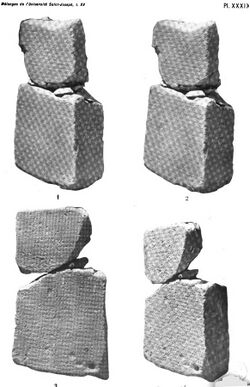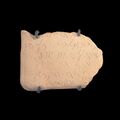Social:Sefire steles
The Sfire or Sefire steles are three 8th-century BCE basalt stelae containing Aramaic inscriptions discovered near Al-Safirah ("Sfire") near Aleppo, Syria.[1] The Sefire treaty inscriptions are the three inscriptions on the steles; they are known as KAI 222-224.[2] A fourth stele, possibly from Sfire, is known as KAI 227 (the "Starcky Tablet", at the Louvre).[3]
Discovery of the inscriptions
Sefire I
Discovered in 1930, it is held in the National Museum of Damascus. This is a basalt slab broken in two horizontally. The first two steles each have three faces bearing writing.
Sefire II
Discovered in 1930, it is held in the National Museum of Damascus. As with Sefire I stele, Sefire II had three faces bearing writing. While most of the text of Sefire II A and B permit coherent translation only with comparison with Sefire I and III, the concluding portion of Sefire II A and B is quite clear.[4][5][6]
Sefire III
Discovered in 1956, Sefire III is made up of nine fragments of the reverse of a broad slab. It is held by the Beirut National Museum.
The inscriptions
The inscriptions record two treaties that "list curses and magical rites which take effect if the treaty is violated."[7]
One is a treaty between two minor kings, Barga'yah and Matti'el, who hailed from the southwestern periphery of the Assyrian empire.[8] In the text, Matti'el swears to accept dire consequences for himself and his cities should he violate the stipulations of the treaty:[8]
"....
As this wax is consumed by fire, thus Ma[tti'el] shall be consumed b[y fi]re.
As this bow and these arrows are broken, thus Inurta and Hadad (= names of local deities) shall break [the bow of Matti'el] and the bows of his nobles.
As a man of wax is blinded, thus Matti'el shall be blinded.
[As] this calf is cut up, thus Matti'el and his nobles shall be cut up."[8]
This loyalty oath from the Sefire inscriptions is similar to other loyalty oaths imposed by Assyrian kings on other less powerful monarchs in the Levant throughout the 8th and 7th centuries BCE.[8]
The inscriptions may, under one possible interpretation, record the names of El and Elyon, "God, God Most High" possibly providing prima facie evidence for a distinction between the two deities first worshipped by the Jebusites in Jerusalem, and then elsewhere throughout the ancient Levant.[9]
Thought to be reflective of Assyrian or neo-Assyrian culture and similar to other documents dating from the first millennium BCE, scholars such as Joseph Fitzmyer have perceived Canaanite influences in the text, while Dennis McCarthy has noted similarities to second millennium BCE treaties imposed by Hittite kings on Syrian vassals.[10]
Identification of the treaty kings
Two treaties conducted between minor kings from the Kingdom of Arpad inscribed on the stelae are often cited as evidence of the Aramaean tradition of treaty-making.[11] The Sefire inscriptions are of interest to those studying beliefs and practices in ancient Syria and Palestine and the text is considered notable for constituting "the best extrabiblical source for West Semitic traditions of covenantal blessings and curses."[1]
They tell of "The treaty of King Bar-ga'yah of K[a]t[a]k, with Mati'el son of Attarsamak, king of Arpad." Some have identified this as the treaty of "Ashurnerari V" (Adad-nirari III or his son Tiglath-pileser III?) of Assyria and Matiilu (unknown) of Arpad (probably modern Tel Rifaat, Syria).[12]
Gallery
References
- ↑ 1.0 1.1 S. A. Kaufman. "Aramaic". Anchor Bible Dictionary. pp. 173–78. Archived from the original on November 4, 2005. https://web.archive.org/web/20051104215025/http://www.nelc.ucla.edu/Faculty/Schniedewind_files/NWSemitic/Aramaic_ABD.pdf.
- ↑ Joseph A. Fitzmyer The Aramaic inscriptions of Sefîre 1967
- ↑ Starcky J. Une tablette araméenne de l'an 34 de Nabuchodonosor.(AO 21063). In: Syria. Tome 37 fascicule 1-2, 1960. pp. 99-115. DOI : https://doi.org/10.3406/syria.1960.5506 and www.persee.fr/doc/syria_0039-7946_1960_num_37_1_5506
- ↑ James Bennett Pritchard The ancient Near East: supplementary texts and pictures 1969 "In Sfire II A 9, lions seem to be mentioned in the same context, offering a good parallel to ... (Sfire II C) (While most of the preserved text of Sfire II A and B permits a coherent translation only where the missing links can be supplied on the basis of Sfire I and III, the concluding portion is quite clear.
- ↑ Holger Gzella, M. L. Folmer Aramaic in its historical and linguistic setting 2008 p153 "personal names: Sfire II, C, 14; place names: Zkr B:10, 11 and perhaps B 4; Sfire II, C, 5; "
- ↑ M. L. Folmer The Aramaic language in the Achaemenid period 1995 p427 "6,8 In combination with the infinitive (hbzthm Sfire ii B 7)"
- ↑ Ann Jeffers (1996). Magic and Divination in Ancient Palestine and Syria. BRILL. p. 18. ISBN 90-04-10513-1.
- ↑ 8.0 8.1 8.2 8.3 Christopher A. Faraone (1993). "Molten Wax, Spilt Wine and Mutilated Animals: Sympathetic Magic in near Eastern and Early Greek Oath Ceremonies". The Journal of Hellenic Studies (The Society for the Promotion of Hellenic Studies) 113: 60–80. doi:10.2307/632398. http://www.wac.ucla.edu/pdf/greekoathceremonies.pdf. Retrieved 2007-10-12. [|permanent dead link|dead link}}]
- ↑ John Day (2000). Yahweh and the Gods and Goddesses of Canaan. Continuum International. p. 20. ISBN 0-8264-6830-6.
- ↑ William Morrow (2001). Paul-Eugène Dion. ed. "The Sefire Treaty Stipulations and the Mesopotamian Treaty Tradition". The World of the Aramaeans (Continuum International): 83–84. ISBN 1-84127-179-9.
- ↑ John F. Healy (13 June 1987). "Ancient Aramaic Culture and the Bible". University of Durham. Archived from the original on August 28, 2008. https://web.archive.org/web/20080828012607/http://www.urhoy.info/culture.pdf. Retrieved 2007-10-12.
- ↑ Grosby, Steven Elliott (2002). Biblical Ideas of Nationality: Ancient and Modern. Eisenbrauns. p. 126. ISBN 9781575060651. https://books.google.com/books?id=HY1pkwuvC3AC&q=KTK&pg=PA126. Retrieved 2020-11-02."Thus, they think that the Sefire treaty is the Aramaic version of the treaty of approximately 754 bc between Ashurnerari V and Matîoil of Arpad. But why the use of KTK as a pseudonym for Assyria? If, in fact, Dupont-Sommer's (1958) ..."
Bibliography
Steles I and II
- Dussaud René. Nouvelles inscriptions araméennes de Séfiré, près d'Alep. In: Comptes rendus des séances de l'Académie des Inscriptions et Belles-Lettres, 75ᵉ année, N. 4, 1931. pp. 312-321. DOI : https://doi.org/10.3406/crai.1931.76102
- Ronzevalle, S., "Fragments d'inscriptions araméennes des environs d'Alep." Mélanges de l'Université Saint-Joseph, 15 (1930-31): 237–60
- Cantineau, Jean, "Remarques sur la stèle araméenne de Sefiré-Soudjin." RA 28 (1931): 167–178
- Hempel, J. and Bauer, H., "Zeitschriftenschau: Mélanges de l'Université Saint-Joseph. Beyrouth (Liban) XV (1930)." ZAW 50 (1932): 178–83
- Driver, G.R., "Notes on the Aramaic Inscription from Soudschin." AfO 8 (1932-33): 203–6
- Friedrich, J. and Landsberger, B., "Zu der altaramäischen Stele von Sudschin." ZA 41 (1933): 313–18
Stele III
- Dupont-Sommer, A. and Starcky, Jean, "Une inscription araméenne inédite de Sfiré." BMB 13 (1956 [appeared 1958]): 23–41 + pls. I-VI. Sf.3
- Dupont-Sommer, A., "Une stèle araméenne inédite de Sfiré (Syrie) du VIIIe siècle avant J.-C.." CRAIBL (1957a): 245–48. Sf.3
- Fitzmyer, Joseph A., "The Aramaic Suzerainty Treaty from Sefire in the Museum of Beirut." CBQ 20 (1958): 444–76. Sf.3
All Steles
- Dupont-Sommer André. Les inscriptions araméennes de Sfiré (stèles I et II). In: Mémoires présentés par divers savants à l'Académie des inscriptions et belles-lettres de l'Institut de France. Première série, Sujets divers d'érudition. Tome 15, 1e partie, 1960. pp. 197-349. DOI : https://doi.org/10.3406/mesav.1960.1129
- Fitzmyer, J. (1961). The Aramaic Inscriptions of Sefire I and II. Journal of the American Oriental Society, 81(3), 178-222. doi:10.2307/595652
- Greenfield, Jonas C., "Three Notes on the Sefire Inscription," JSS 11 (1966), 98-105.









